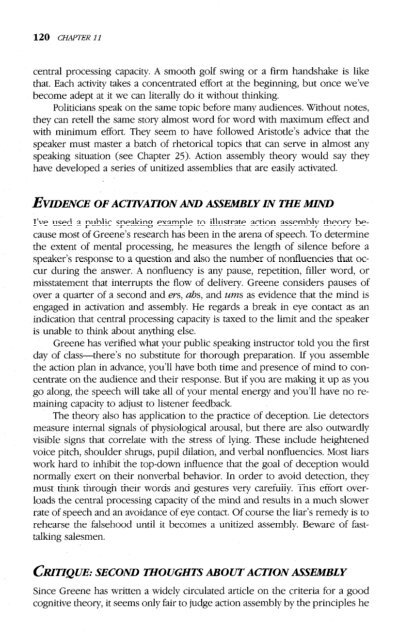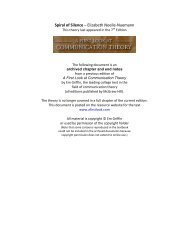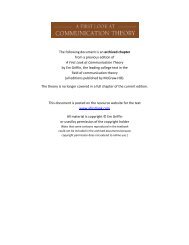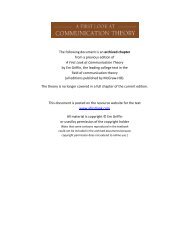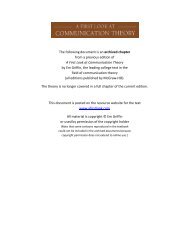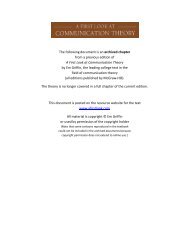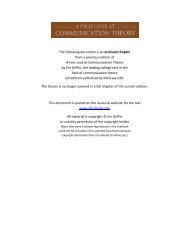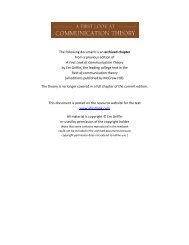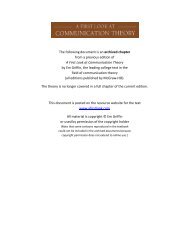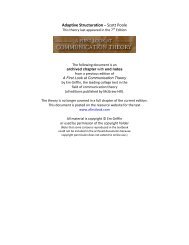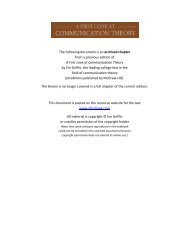Action Assembly Theory (PDF) - A First Look at Communication Theory
Action Assembly Theory (PDF) - A First Look at Communication Theory
Action Assembly Theory (PDF) - A First Look at Communication Theory
Create successful ePaper yourself
Turn your PDF publications into a flip-book with our unique Google optimized e-Paper software.
120 CHAPTER 11<br />
central processing capacity. A smooth golf swing or a firm handshake is like<br />
th<strong>at</strong>. Each activity takes a concentr<strong>at</strong>ed effort <strong>at</strong> the beginning, but once we’ve<br />
become adept <strong>at</strong> it we can literally do it without thinking.<br />
Politicians speak on the same topic before many audiences. Without notes,<br />
they can retell the same story almost word for word with maximum effect and<br />
with minimum effort. They seem to have followed Aristotle’s advice th<strong>at</strong> the<br />
speaker must master a b<strong>at</strong>ch of rhetorical topics th<strong>at</strong> can serve in almost any<br />
speaking situ<strong>at</strong>ion (see Chapter 25). <strong>Action</strong> assembly theory would say they<br />
have developed a series of unitized assemblies th<strong>at</strong> are easily activ<strong>at</strong>ed.<br />
EVIDENCE OF ACTNATION AND ASSEMBLY IN ZHE MIND<br />
I’ve used a public speaking example to illustr<strong>at</strong>e action assembly theory because<br />
most of Greene’s research has been in the arena of speech. To determine<br />
the extent of mental processing, he measures the length of silence before a<br />
speaker’s response to a question and also the number of nonfluencies th<strong>at</strong> occur<br />
during the answer. A nonfluency is any pause, repetition, filler word, or<br />
misst<strong>at</strong>ement th<strong>at</strong> interrupts the flow of delivery. Greene considers pauses of<br />
over a quarter of a second and ers, ahs, and urns as evidence th<strong>at</strong> the mind is<br />
engaged in activ<strong>at</strong>ion and assembly. He regards a break in eye contact as an<br />
indic<strong>at</strong>ion th<strong>at</strong> central processing capacity is taxed to the limit and the speaker<br />
is unable to think about anything else.<br />
Greene has verified wh<strong>at</strong> your public speaking instructor told you the first<br />
day of class-there’s no substitute for thorough prepar<strong>at</strong>ion. If you assemble<br />
the action plan in advance, you’ll have both time and presence of mind to concentr<strong>at</strong>e<br />
on the audience and their response. But if you are making it up as you<br />
go along, the speech will take all of your mental energy and you’ll have no remaining<br />
capacity to adjust to listener feedback.<br />
The theory also has applic<strong>at</strong>ion to the practice of deception. Lie detectors<br />
measure internal signals of physiological arousal, but there are also outwardly<br />
visible signs th<strong>at</strong> correl<strong>at</strong>e with the stress of lying. These include heightened<br />
voice pitch, shoulder shrugs, pupil dil<strong>at</strong>ion, and verbal nonfluencies. Most liars<br />
work hard to inhibit me top-down influence th<strong>at</strong> the goal of deception would<br />
normally exert on their nonverbal behavior. In order to avoid detection, they<br />
must think through their words and gestures very carefully. This effort overloads<br />
the central processing capacity of the mind and results in a much slower<br />
r<strong>at</strong>e of speech and an avoidance of eye contact. Of course the liar’s remedy is to<br />
rehearse the falsehood until it becomes a unitized assembly. Beware of fasttalking<br />
salesmen.<br />
CRITIQUE: SECOND THOUGHTS ABOUT ACTION ASSEMBLY<br />
Since Greene has written a widely circul<strong>at</strong>ed article on the criteria for a good<br />
cognitive theory, it seems only fair to judge action assembly by the principles he


